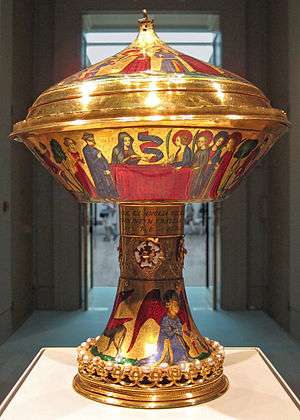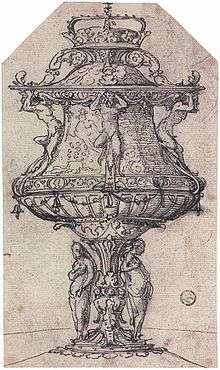Inventory of Elizabeth I of England
The Inventory of Jewels and Plate of Queen Elizabeth I of England in 1574 was published from manuscripts by Arthur Jefferies Collins in 1955. The published inventory describes jewels and silver-plate belonging to Elizabeth I of England with detailed references to other source material.
Introduction
The sources used by Collins were British Library Harley MS. 1560 and Stowe MS.555. The manuscripts represent the "Quenis Majesties juelles plate and other stuff" in 1574 and additions by gift or purchase over the next 20 years which were kept in the Jewel House at the Tower of London. Collins also collated information from other books and manuscripts to cross-reference information about the objects listed. Gifts of plate to the queen passed from the Privy Chamber to the Jewel House. Some pieces were melted down and others were given as diplomatic gifts. When the queen travelled, the towns she visited often gave her gifts of silver-gilt cups.
In 1574 the office of the Jewel House was located in a two-storey building on the south side of the White Tower. This contained the records of the jewels and packing materials for sending jewels to court.[1] Until the Restoration in 1660, the Jewel House contained the monarch's personal collection of jewellery as well as the royal plate and the inalienable state regalia.[2] The coronation regalia were kept separately at Westminster Abbey.[3] Many items of personal jewellery from the Jewel House were pawned or sold by Charles I during the early 17th century, and most of the plate and regalia were melted down and turned into coins by Parliament during the English Civil War.[4]
A list of jewels in the possession of Anne of Denmark in 1606 was published by Diana Scarisbrick.[5]
The 1574 inventory was made John Astley, Master and Treasurer of the Jewel House. The Master had an annual salary of £50 and was able to exact payments from goldsmiths appointed to work for the Jewel House, and those who transported plate from the House to diplomats. The post was lucrative, but some of the perquisites of the role were exaggerated or overstated by Sir Gilbert Talbot, who was made Master in 1660 and in 1680 wrote a treatise 'Of the Jewel house'.[6]
In the inventory the items were listed in categories; below the main categories are given with some examples of the 1,605 entries.
Gold plate
- Juelles of Golde
- no. 1 The imperial crown of England.
- no. 2 The sceptre of gold with a dove.
- no. 3 The globe or round ball (orb) with a cross.
- no. 4 The queen's crown (intended for a queen consort).
- no. 5 The queen's sceptre (intended for a queen consort).
- no. 6 A pair of bracelets with six rubies and seven large pearls and five smaller pearls, with red laces.[7]
- Cups and bowls

- no. 48 A cup of gold with imagery the knop a crown imperial and about border of the cover and the foot a crown garnished with 61 pearls.[8]
- no. 49 A jewelled gold cup given to James VI of Scotland at the christening of Prince Henry on 30 August 1594.[9]
- no. 75 A cup of "assaye" of gold fair wrought and enamelled. Given to Christian IV of Denmark on 5 August 1606.[10]
- Candlesticks
- no. 77: Four gold candlesticks for a table with "H" and "R" enamelled in red. Three were gifts to Henry VIII from Catherine of Aragon.[11]
- Goblets and jugs
- Salt cellars
- no. 83 A salt called the "Morris Dance" decorated with precious stones and pearls with 5 morris dancers and a lady. The salt was taken to The Hague in October 1625 by the Duke of Buckingham and pawned.[12]
- Orange-strainers
- Trenchers
- Spoons and forks
- Basins, ewers and lairs
- Glasses
- Casting-bottles
Silver, silver-gilt, and parcel-gilt plate
- Crosses
- Book-covers
- A baptismal font
- no. 159 The silver-gilt font was decorated with pomegranates (the emblem of Catherine of Aragon), roses, and "antique" (renaissance style) decoration. It was made for Mary I of England in 1555.[13]
- Church plate
- Mitres
- Cups and cups of assay
- no. 215 An "Antique" (renaissance style) gilt cup with a cover with a letter "D". Given in 1604 to Jean Grusset Richardot, President of the Privy Council of the Netherlands.[14]
- no 356 A cup called a "colloke" made of serpentine with a silver-gilt cover, given by Sir John Mason as a New Year's gift in 1562. The silver was sent to the mint to be made into coin in 1600.[15]
- Bowls
- Bowls (gilt)
- Bowls (parcel-gilt and silver)
- Pots (gilt)
- Pots (parcel-gilt and silver)
- Flagons and casting bottles (gilt)
- Flagons of glass or stone bound in velvet
- Spice plates
- Spice boxes
- Candlesticks and snuffers
- Spoons
- Goblets and glasses
- Jugs
- Tankards and Hanse pots
- Cruises (A type of tankard)
- Stoneware jugs
- Salt cellars
- no. 998 A basin of silver-gilt designed by Hans Holbein the younger for Anne Boleyn.[16]
 The table fountain designed by Holbein for Anne Boleyn was item no. 998 in the 1574 inventory
The table fountain designed by Holbein for Anne Boleyn was item no. 998 in the 1574 inventory
- no. 998 A basin of silver-gilt designed by Hans Holbein the younger for Anne Boleyn.[16]
- Basins, fountains, ewers and gilt lairs (a lair was a kind of ewer)
- Basins and ewers (parcel-gilt and silver)
- Chafing dishes
- Trenchers
- Knives
- 'Vessell' (gilt, parcel-gilt and silver)
- Kitchen plate
- Orange strainers
- Perfume pans
"Sundry parcelles"
- no. 1375 A gunpowder flask taken from the body of James IV at the Battle of Flodden.[17]
Plate received on 10 January 1574 from the grooms of the Privy Chamber
- no.1398 A cup of gold with cover holding an escutcheon given by the townsmen of Sandwich on 31 August 1573.
Additions recorded to 12 August 1594
- no. 1483 Three gilt bowls with covers given by the town of Yarmouth in August 1578. Elizabeth did not visit the town because of an outbreak of plague.
- no. 1484 A fair standing bowl with a silver cover decorated with scenes of the story of Joseph given by the members of the Dutch church in Norwich on 19 August 1578.
- no. 1485 A cup with a cover of silver gilt given by the town of Thetford in August 1578.[18]
See also
- Crown Jewels of the United Kingdom
- Inventory of Henry VIII of England
- Craven Ord, ed. An Inventory of Crown Jewels in the Reign of Edward III. Archaeologia, vol X, 1792
- Scottish Royal tapestry collection
References
- ↑ Collins, pp. 3, 35.
- ↑ Keay, p. 114.
- ↑ Keay, p. 34.
- ↑ Keay, pp. 37–40.
- ↑ D. Scarisbrick, 'Anne of Denmark's Jewellery Inventory', Archaeologia, vol. CIX, 193–237. The manuscript is kept by the National Library of Scotland
- ↑ Collins, pp. 223-5: Archaeologia, XII, pp.115-23: British Library Add. 34359: Several other copies of Talbot's treatise survive in manuscript
- ↑ Collins, pp. 264–267.
- ↑ Collins, pp. 279–281.
- ↑ Collins, pp. 281.
- ↑ Collins, p.287
- ↑ Collins, pp.287-8
- ↑ Collins, p.289-90
- ↑ Collins, p. 310.
- ↑ Collins, p. 323.
- ↑ Collins, p. 350.
- ↑ Collins, pp. 468–469.
- ↑ Collins, pp. 538–239.
- ↑ Collins, p. 565.
Bibliography
- Collins, Arthur Jefferies (1955). Jewels and Plate of Queen Elizabeth I: The Inventory of 1574. Trustees of the British Museum. ASIN B0006EIQUG.
- Keay, Anna (2011). The Crown Jewels: The Official Illustrated History. Thames & Hudson. ISBN 978-0-500-51575-4.